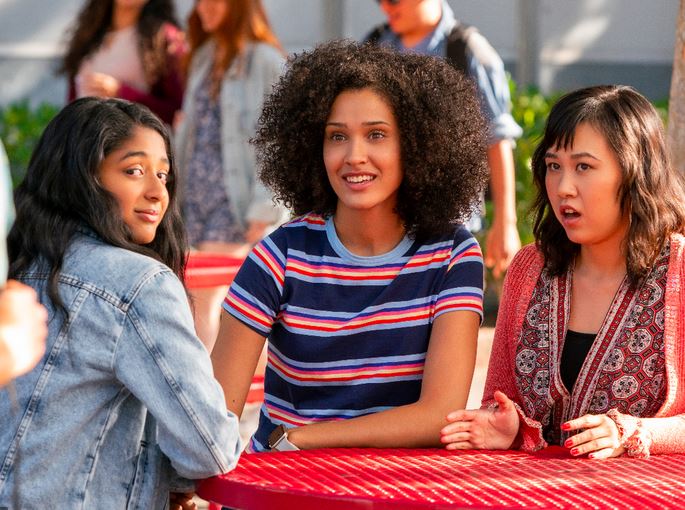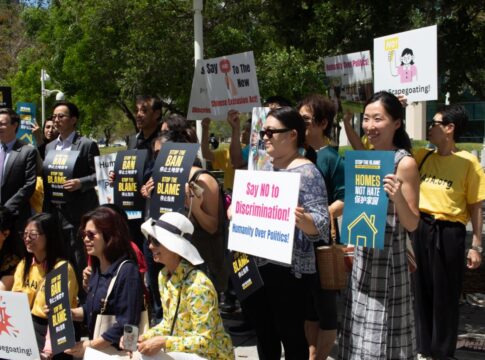With a snap of the fingers, relatively speaking, we have three shows on television with South Asian leads. If you count reruns of Priyanka Chopra’s Quantico and Mindy Kaling’s The Mindy Project, South Asians have gained unprecedented visibility on US TV.
The Asian Pacific American Media Coalition (APAMC) on March 24 heralded the premiere of two new television series on cable networks that feature South Asian Americans: the unscripted Family Karma on Bravo and the animated Mira: The Royal Detective on Disney Junior. The following month, Kaling’s sitcom Never Have I Ever debuted introducing an Indian American perspective to the coming-of-age genre
For years, APAMC has advocated for greater diversity and inclusion of Asian Americans in Hollywood-produced programming.
“While South Asian Americans are glad to be represented, they also yearn for the chance to tell their own stories. That is why we applaud the entry of two new series that center Indian or Indian American life and culture.
LATEST STORIES
“When APAMC met several years ago with NBCUniversal, we noted the absence of Asian Americans on the cable network Bravo, known for its pop culture personalities. We’re glad the network found a way to include us,” said APAMC Chair Daniel Mayeda. The APAMC—the only organization to have graded the top four television networks since 2001—issued its annual Report Cards for the past 2018-19 season, assessing the four major TV networks on their progress toward diversity and inclusion of Asian Pacific Americans (APAs) onscreen and behind the camera.
Although ABC and CBS maintained their same grades for Actors and NBC increased (from C to C+), the Coalition fears that the unprecedented success of Crazy Rich Asians in the Summer of 2018 failed to boost significantly the number of APA-led series on network TV. ABC had three pilots in contention that would have starred APAs (first name in the credits), including two that would have featured Asian American families. NBC had a pilot about an Asian American magician, and CBS was considering an Asian American family sitcom including Ken Jeong as a cast member. But none of them made the 2018-19 line-up.
“Since the APAMC began meeting with the networks in 1999,” noted Mayeda, “we have generally seen an improvement in the various categories (such as Actors, Unscripted, Writers/Producers, Directors). For example, in the 2002-03 season, onscreen representation of APAs was so bad, we gave two networks Fs in the Actors category. As part of the larger Multi-Ethnic Media Coalition (MEMC) —which also includes the NAACP, National Latino Media Council, and American Indians in Film/TV—we pushed the networks to sign Memoranda of Understanding (MOUs), create diversity departments, actors showcases, writers and directors programs, and other pipeline programs.”
But progress has plateaued in many cases for the networks, with Fox recording its lowest grade in the Actors category (D+) in the past 18 years.
The biggest gains for APAs now seem to be happening in non-network media, including streaming services Netflix (Master of None, To All the Boys I’ve Loved Before parts 1 and 2, Ugly Delicious, Patriot Act with Hasan Minhaj, Always Be My Maybe, Tigertail, Never Have I Ever, The Half of It), Amazon Prime (Man in the High Castle, Warrior), and Hulu (PEN15); cable channels Comedy Central (Awkwafina is Nora from Queens, Ronny Chieng: International Student), AMC (Into the Badlands, Killing Eve, The Terror: Infamy), Bravo (Family Karma), and Disney Channel (Andi Mack, Mira, Royal Detective); and theatrically-released motion pictures (Searching, The Farewell, Plus One, Stuber).
“While we continue to advocate for the networks to feature more APAs in leading roles, the Coalition applauds the increased inclusion of APAs in other venues,” Mayeda said. “We recognize that many of these programs and films would not have been possible without the training and opportunities created by the networks’ diversity efforts. But the networks themselves need to redouble their efforts to avoid slipping behind their streaming and cable counterparts in representing APAs.”

ABC received the highest overall grade — a “B” — for the third year in a row and led with the highest grade in five of the seven categories: Actors (A-; third consecutive year), Commitment to Diversity (A; likewise), Development (B+), Directors (B+; tied with CBS), and Writers/Producers (B).
CBS came in second earning an overall grade of B-, Fox maintained its C grade followed by NBC’s C- (a huge improvement from the previous year’s F grade).
APAMC members include Asian Americans Advancing Justice-AAJC, East West Players, Japanese American Citizens League, Media Action Network for Asian Americans, National Coalition of Asian Pacific Americans, National Federation of Filipino American Associations, OCA-Asian Pacific American Advocates, Sikh American Legal Defense and Education Fund, and Visual Communications.
With the loss of Fresh Off the Boat and Marvel’s Agents of S.H.I.E.L.D., ABC will be hard-pressed to maintain its grade next year.
In fact, with the 10th and final season of Hawaii Five-O, The Good Place, the single season of The Terror: Infamy largely set in a WWII Japanese American internment camp, the final installment of Man In the High Castle, the cancellation of the martial-arts dystopian Into the Badlands and the end Disney’s Andi Mack, television will likely be lacking in an AAPI presence overall.

One area the networks can improve on is coverage of AAPI is the news.
“Given the backlash many Asian Americans have faced because of COVID-19, we urge the networks to also produce news stories on this rising concern as well as the remarkable contributions our communities have made to this country,” added Rita Pin Ahrens, Executive Director of OCA—Asian Pacific American Advocates, an APAMC member organization.
The AAPI audience is moving to other media for their news and entertainment. According to Nielsen, the Asian American community is the most plugged-in ethnic group and mostly depend on online sources for entertainment by AAPI artists, vlogs and communication via social media.
“After the mega success of Crazy Rich Asians,” says founding APAMC member Guy Aoki, “other Asian American projects have done well, including Always Be My Maybe, To All the Boys I’ve Loved Before, and The Farewell. And the Korean drama Parasite became the first international film to win the Oscar for best picture. We don’t want to lose momentum and want to remind Hollywood that what we learned from those successes still holds true: people of all races are interested in stories about Asian people and are willing to pay money to see them.”
Aoki adds: “We want the networks to re-commit to getting Asian American family shows back on the air, which people will gladly watch for free.”
AsAmNews has Asian America in its heart. We’re an all-volunteer effort of dedicated staff and interns. Check out our new Instagram account. Go to our Twitter feed and Facebook page for more content. Please consider interning, joining our staff, or submitting a story.








